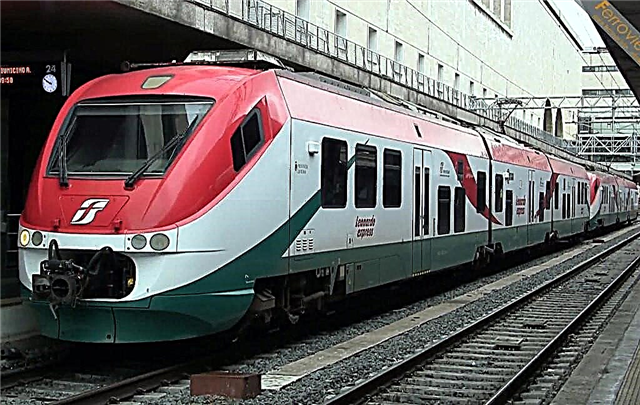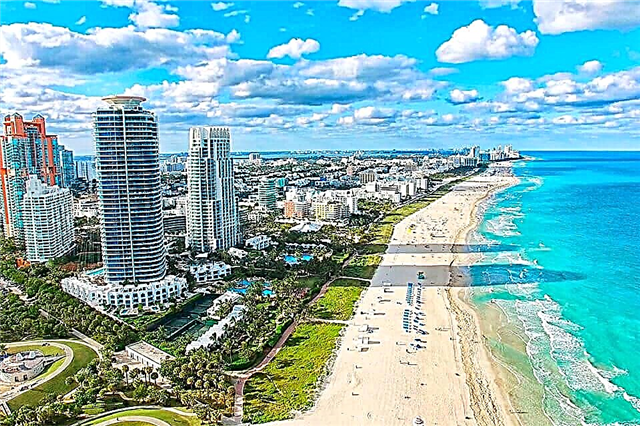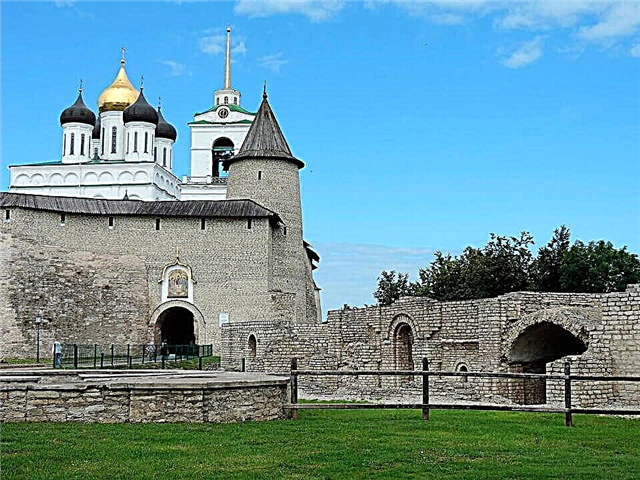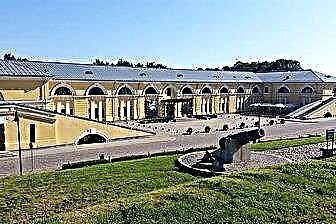Address: Russia, Yaroslavl region, Yaroslavl, st. Bolshaya Oktyabrskaya, 41
Main attractions: Church of the Praise of the Mother of God (1677), the Church of the Shuya Smolensk Icon of the Mother of God (1673)
Shrines: The Smolensk icon of the Mother of God, a particle of the relics of the great martyr Demetrius of Thessaloniki
Coordinates: 57 ° 37'18.6 "N 39 ° 52'52.8" E
Content:
Two adjacent Orthodox churches - in honor of the great martyr Dmitry of Thessaloniki and the Praise of the Mother of God - make up a single Dmitrovsky parish. They are a real decoration of ancient Yaroslavl and are located in the very center of the sprawling city. These ancient churches attract many pilgrims and tourists traveling to the cities of the "Golden Ring" of Russia, not only for their picturesque appearance, but also for the frescoes that have survived from the 17th century.
The history of the construction of the Dmitrovsky and Pokhvalsky temples
The very first Dmitrovskaya church has been known since the second half of the XIV century. She stood in the suburbs of Yaroslavl, near the place where the river Netecha flowed into Korotosl. The church was built after the return of the Yaroslavl military squad, and became a symbol of the victory of the Russian army on the Kulikovo field. Therefore, the temple was consecrated in honor of the heavenly patron of Prince Dmitry Donskoy - the great martyr Dmitry Solunsky.

From left to right: the Church of the Shuya Smolensk Icon of the Mother of God, the Church of the Praise of the Mother of God
Gradually, a military cemetery was built around the church, where residents of the city who died in battles were buried. The Yaroslavl people, veterans of the Battle of Kulikovo, were the first to be buried on it. Later, the church and the cemetery began to be perceived by everyone as a kind of symbol of victory over the Horde and a memorial place where prayers were held in memory of those who died on the battlefield or died from wounds and mutilations.
Written evidence of the existence of the wooden church dates back to the middle of the 16th century. They mention the existence of the church of St. Demetrius on Netich. It is also known that this church burned down in 1580, but was rebuilt again and stood until the 40s of the 17th century.
The Church of Praise is mentioned in written records of the early 17th century. It is known that this wooden temple had two altars. His second throne was dedicated to Saint George. Over time, the Church of the Praise of the Virgin fell into decay, and in 1645 the priest and parishioners turned to the Metropolitan for permission to dismantle the old church and build a new one in its place. Having received consent, the townspeople built two new wooden churches - Dmitrovsky and Pokhvalsky.
It is known that the iconographers Macarius and Vasily Agafonov painted the Dmitrov Church. At that time, the use of military symbols began to decrease in the design of temples. A long time has passed since the Battle of Kulikovo, and the city has experienced many new upheavals. So, in 1654, after an epidemic of pestilence, many ordinary residents were buried at the military church cemetery.
But less than two decades had passed, and both churches burned down to the ground during the terrible Yaroslavl fire in 1658. The Praise Church was rebuilt first. And for a long time they could not raise the necessary funds for Dmitrovskaya. The brick temple was built with money donated by parishioners only in 1671-1673. It is also known that for the completion of the new church, with the permission of the sovereign Alexei Mikhailovich, the materials left over from the construction of the city towers were used - 955 carts of solid and half bricks.

View of the Church of the Shuiskaya Smolensk Icon of the Mother of God from the side of Mukomolny Lane
Parish history from the 17th century to the present
The main altar of the stone Dmitrov Church was consecrated in honor of the revered image of the Mother of God of Smolensk and Shuiskaya. This choice was not accidental. This version of the icon was painted by Shuya craftsmen in honor of the end of the plague epidemic and reminded Yaroslavl residents of relatives who died from a terrible disease in the middle of the 17th century.
Soon, in 1677, with the permission of Metropolitan Jonah Sysoevich, the Church of Praise was also rebuilt in stone. Unlike the cold Dmitrovsky church, where services were held only in the warm season, the small Pokhvalskaya church became a winter, warm church of the parish.
In 1686, the Dmitrov Church was decorated with wall paintings inside. And at the beginning of the 18th century, covered galleries were added to it on both sides. In 1748, the Pohval Church was rebuilt practically from scratch, applying new architectural and artistic techniques in the new building.
Throughout history, philanthropists have supported parish life. With their money, the necessary restructuring and repairs were carried out. According to documents of the late 19th - early 20th centuries, it is known that the Dmitrov parish received significant financial contributions from the Yaroslavl merchants Spiridon Anisimovich Poletaev and Nikolai Maksimovich Kuznetsov. With their money, they built a new gouging, ordered a new iconostasis, decorated the church walls with new paintings, and also bought silver utensils for divine services and crowns for temple icons.
During the Left Esser uprising against Soviet rule in 1918, both churches were badly damaged by shrapnel and shells. In the Dmitrov Church, the head was broken, the tent of the bell tower was destroyed, and in some places the walls were pierced through. After 6 years, the parishioners carried out restoration work in the church, which was supervised by specialists from the Yaroslavl restoration workshops.
Then, according to the new policy of the state, all valuable property was confiscated from both churches. Dmitrovsky temple has been closed to believers since 1929, and Pokhvalsky - since 1935. In the Dmitrovskaya church, at first, a warehouse was located, which was owned by a local confectionery factory, as well as residential apartments of the townspeople. A little later, the building was severely disfigured by taking apart the remaining chapter. From the early 1970s to the early 1980s, a full-scale restoration took place in the Dmitrov Church.

View of the Church of the Shuiskaya Smolensk Icon of the Mother of God from st. Sobinova
The return of the churches to the parishioners took place in 1991. Services in the Pokhvalskaya church began to be held a year later, and in Dmitrovskaya - only since 2003, since the building required extensive repair and restoration work.
Architecture and interior decoration
Dmitrovskaya and Pokhvalskaya churches have been rebuilt several times throughout their history. The two-pillar Dmitrovsky temple was originally five-domed and had a podzakomarny covering. In the 19th century, four chapters were dismantled, and the roof was replaced with a more practical four-pitched roof. A little later, from the west, a porch in the classical style was added to the temple, noticeably discordant with the main ensemble. Nowadays, the church is cubic at its base and is crowned with one chapter, located on a drum of light.
The Dmitrov temple has no basement and stands on a foundation of cobblestones or, as they used to say, on a “wild stone”. Compositionally, it is similar to the Church of St. Nicholas Nadeidin, which at one time served as a model for many Yaroslavl religious buildings. The platbands of this temple have very beautiful decor. They are decorated with slender ribs and an expressive keeled top.
A bell tower is installed from the northwest of the main volume. It has a powerful quadrangular base and a hipped roof, with carved auditory openings (or lucarnes).
Despite the picturesque appearance, the main treasure of the Dmitry Thessalon Church is located inside. These are wall frescoes that have survived from the 80s of the 17th century. It is known that the isographic works were carried out by an artel of masters under the guidance of the famous icon painter, known far beyond the borders of Yaroslavl, Dmitry Plekhanov. In total, the masters created 186 pictorial hallmarks that reveal the main gospel stories. Experts consider these murals to be one of the best examples of the Yaroslavl art school.
The Pokvalskaya Church is a squat wintery quadrangular temple with one wide altar apse. Like the Dmitrovskaya church, the Pokhvalsky temple was built on a cobblestone foundation. This temple acquired its current classical features during the last major reconstruction in 1809. Its main volume is covered with a semicircular wooden dome, which is crowned with a single thin, graceful dome. On both sides of the building are attached porticoes decorated with columns, as well as a squat refectory under a gable roof.

View of the northern facade of the Church of the Shuya Smolensk Icon of the Mother of God
The current state of the temples
Both churches are active. There are three thrones in the Dmitrov Church - in honor of the great martyr Dmitry of Thessaloniki, St. George and Tsarevich Alexei. The warm Pokhvalsky temple belongs to the Dmitrov parish.
How to get to the church of Dmitry Solunsky
Dmitrovskaya church is located in Yaroslavl on the street. Bol. Oktyabrskaya (former Rozhdestvenskaya), 41.
By car. The federal highway M8 leads from Moscow to Yaroslavl. Within the city limits, it is called Moskovsky Prospekt. On it you need to cross the bridge over the Korotosl River. And then from the Epiphany Square - turn left onto Bolshaya Oktyabrskaya Street, which leads to the temple.
By train. From Moscow to Yaroslavl, express train trains reach in 3 hours 16 minutes. The journey by regular train takes from 4 to 5.5 hours. From Moskovsky Train Station in Yaroslavl, the distance to the Dmitry Solunsky Church is 3 km. You can walk to it or take a taxi.











